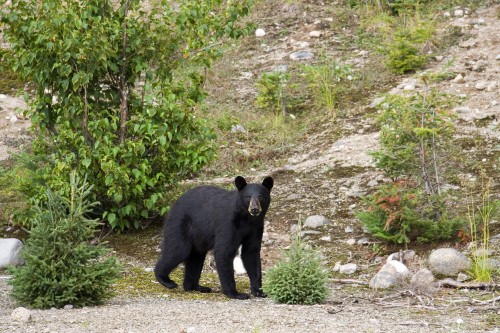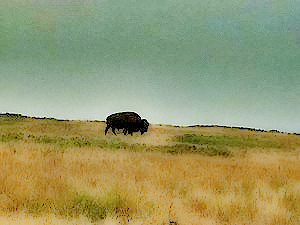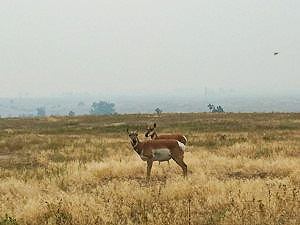Audio postcard: smokey bears
 Occasionally, we take you behind the scenes of an interesting recording. Recently,
Acoustic Atlas Program Director Jeff Rice captured the unusual sound of a black bear
at the National Bison Range in western Montana. Read on and then take a listen.
Occasionally, we take you behind the scenes of an interesting recording. Recently,
Acoustic Atlas Program Director Jeff Rice captured the unusual sound of a black bear
at the National Bison Range in western Montana. Read on and then take a listen.

Bison roaming the National Bison Range. Photo by Jeff Rice.
The place: The National Bison Range was created in 1908 by Teddy Roosevelt as habitat for the nation’s endangered bison population. As many as 30 to 60 million bison once roamed the Western United States, but by the late 1880s, a relentless campaign of hunting and outright slaughter had destroyed almost all of them. At one point, as few as 100 individuals were thought to remain in the wild. By Roosevelt’s day, recovery efforts had started to take hold, and the National Bison Range was the first time that Congress had appropriated money to buy land aimed at wildlife conservation. It marked one of the earliest successes of the National Wildlife Refuge system
Today, bison in the West number in the hundreds of thousands, mostly on private ranches. They remain an important fixture on the refuge, along with pronghorn antelope, bighorn sheep, and imposing herds of elk and deer—habitat for bison means more habitat for other species too, which makes the range a great place for nature recording.
The recording: This was the second year that I have visited the National Bison Range, but I wasn’t sure what to expect. Wildfires and an oppressive drought have been affecting much of the West, and in late August, the range (like much of Montana, it seemed) was hazy with smoke. The place was strangely quiet under this grey shroud, devoid of many of the usual choruses of birds and insects.

Pronghorn antelope graze at the National Bison Range against a backdrop of smoke from nearby forest fires. Photo by Jeff Rice.
At the same time, some of the larger animals were more present than I had remembered. Bison were common as you might expect, but I also noticed that several black bears were out feeding on berries in one of the lower valleys. (For that and other reasons, visitors are not allowed to stray from their cars along some of the travel routes. I received special permission from the Refuge to make recordings.)
Late in the day, I set up to record in a clearing just off the road. It was not far from where I had seen the bears, so I kept the car running and worked fast. As I stashed the microphones behind some bushes, I couldn’t help but think of the Forest Service’s ursine mascot, Smokey. The smell of smoke on the range was constant. My eyes burned. I wondered about the animals—and the people—that have been living with these conditions for weeks. There was talk of rain, but it hadn’t come yet and relief was far away. I rubbed my eyes, set the recorder to run all night, and left.
When I returned the next morning, I wasn’t sure if I had had any luck, but I packed up the equipment and made the long trek back home. Back at the studio, I scanned through the hours of tape. The chirring of crickets dominated most of the soundscape, but just as the sun was starting to rise—the timer indicated that it was at about 6 AM in the recording—I saw a spike in the digital waveform indicating that something new had happened. I leaned in and listened. There it was: the unmistakeable sound of a black bear.
Listen to Black Bear tongue clicks and grunts on SoundCloud
These particular sounds are referred to as “tongue clicks” and biologist Lynn Rogers, founder of the North American Bear Center, tells me they may represent a bear communicating with its cubs. Black bears will sometimes grunt and click earnestly when they are concerned or nervous for their cubs, or sometimes when they are just feeling social. I had seen two bear cubs playing and eating about 100 yards from where I recorded, so this seemed like a good likelihood. It’s also quite possible that they were curious about my microphone. It occurred to me that I had set up my recording equipment in the equivalent of their living room. That might cause anyone to comment.
Listen to more bear recordings on the Acoustic Atlas at acousticatlas.org.
